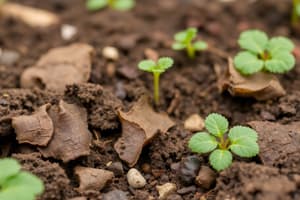Podcast
Questions and Answers
What is the primary composition of organic matter in soil?
What is the primary composition of organic matter in soil?
- Calcium compounds
- Magnesium salts
- Oxygen molecules
- Simple sugars (correct)
Which of the following roles does organic matter play in soil?
Which of the following roles does organic matter play in soil?
- Reduces soil structure
- Enhances aeration (correct)
- Lowers nutrient availability
- Decreases water-holding capacity
What percentage of the soil's total weight do minerals typically make up?
What percentage of the soil's total weight do minerals typically make up?
- 30%
- 45%
- 80%
- 60% (correct)
Which of the following is NOT a primary mineral found in soil?
Which of the following is NOT a primary mineral found in soil?
What essential nutrients are released through the breakdown of organic compounds by microorganisms in the soil?
What essential nutrients are released through the breakdown of organic compounds by microorganisms in the soil?
Which component of soil plays a crucial role in maintaining productive and sustainable agricultural practices?
Which component of soil plays a crucial role in maintaining productive and sustainable agricultural practices?
What is the primary component of organic soil?
What is the primary component of organic soil?
What distinguishes organic soils from inorganic soils?
What distinguishes organic soils from inorganic soils?
What role does soil humus play in soil fertility and plant growth?
What role does soil humus play in soil fertility and plant growth?
Which process results in the formation of soil humus?
Which process results in the formation of soil humus?
What is the main function of clay in controlling soil properties?
What is the main function of clay in controlling soil properties?
Where do organic soils typically form?
Where do organic soils typically form?
Study Notes
Unraveling Soil Chemistry: Organic Matter, Inorganic Soil, Organic Soil, and Humus
Soil is the complex and dynamic interface between the Earth's crust and its living organisms. Its chemical composition is influenced by a variety of factors, and understanding soil chemistry is essential to maintaining productive and sustainable agricultural practices. This article will explore the subtopics of organic matter, inorganic soil, organic soil, and humus, which play crucial roles in the chemistry of our soils.
Organic Matter
Organic matter is the fraction of soil composed of living organisms, their by-products, and dead organic remains. It originates from plants, animals, and microorganisms. Organic matter enhances soil structure, improves aeration, and increases water-holding capacity.
Organic matter is primarily composed of organic compounds, such as:
- Simple sugars
- Nucleic acids
- Amino acids
- Starches
- Lignin
- Cellulose
These organic compounds are broken down by microorganisms in the soil, leading to the release of essential nutrients such as carbon, nitrogen, and phosphorus.
Inorganic Soil
Inorganic soil components consist of the non-organic fraction, including minerals, water, and air. Minerals are the major inorganic constituents, making up approximately 60% of the soil's total weight. The primary minerals in soil are:
- Sand (SiO₂)
- Silt (SiO₂, Al₂O₃, and Fe₂O₃)
- Clay (SiO₂, Al₂O₃, and Fe₂O₃)
Inorganic soil fractions control the physical properties of the soil, such as texture, structure, and porosity.
Organic Soil
Organic soil, also known as peat or muck, is soil that primarily consists of organic matter. Organic soils contain over 30% organic matter and have a significantly lower bulk density and higher water-holding capacity than inorganic soils. Organic soils typically form in wet environments, such as marshes, bogs, and fens. They are often used for agriculture in regions with a high water table or for the production of peat moss.
Soil Humus
Soil humus is the stable, dark, and partially decomposed organic matter that remains in the soil after the process of humification. Humification is the process in which organic matter is slowly broken down by microorganisms into more resistant, water-stable compounds. Humus contributes to soil structure, increases water-holding capacity, and provides a reservoir for essential nutrients. Soil humus also promotes soil fertility and plant growth by improving nutrient availability and enhancing microbial activity.
Soil chemistry is an interconnected web of organic and inorganic components that work together to sustain soil fertility and plant growth. Understanding these subtopics is crucial for enhancing agricultural practices, mitigating soil degradation, and improving soil health. By incorporating organic matter and humus into agricultural systems, we can support sustainable agricultural practices and ensure food security for a growing global population.
Studying That Suits You
Use AI to generate personalized quizzes and flashcards to suit your learning preferences.
Description
Test your knowledge on the key components that make up soil chemistry, including organic matter, inorganic soil, organic soil, and humus. Explore the roles of these components in soil fertility, structure, and nutrient availability.




